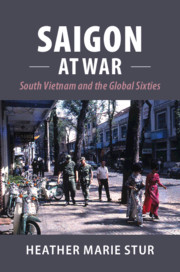Book contents
- Saigon at War
- Cambridge Studies in US Foreign Relations
- Saigon at War
- Copyright page
- Dedication
- Contents
- Figures
- Acknowledgments
- Introduction
- 1 The Heart of South Vietnam
- 2 A Tradition of Activism
- 3 South Vietnam’s Sixties Youth
- 4 South Vietnam and the World
- 5 Building Connections between the People and the Government
- 6 Saigon after Tet
- 7 The Catholic Opposition and Political Repression
- 8 Saigon in the Seventies
- Conclusion
- Select Bibliography
- Index
4 - South Vietnam and the World
Published online by Cambridge University Press: 15 May 2020
- Saigon at War
- Cambridge Studies in US Foreign Relations
- Saigon at War
- Copyright page
- Dedication
- Contents
- Figures
- Acknowledgments
- Introduction
- 1 The Heart of South Vietnam
- 2 A Tradition of Activism
- 3 South Vietnam’s Sixties Youth
- 4 South Vietnam and the World
- 5 Building Connections between the People and the Government
- 6 Saigon after Tet
- 7 The Catholic Opposition and Political Repression
- 8 Saigon in the Seventies
- Conclusion
- Select Bibliography
- Index
Summary
A crowd of several hundred students and other protesters in Radhus Square in Copenhagen on an October afternoon in 1965 quieted as a North Vietnamese student stepped to the podium. His comments were expected to validate the demonstrators’ opposition to US involvement in Vietnam, and that seemed to be the case as he declared in German that the United States must get out of South Vietnam. When he followed that statement with “after, of course, the Communists get out of South Vietnam, for it is they who started the terror and the war there,” confused chatter from the audience rose to a din as protest organizers scrambled to make sense of what was going on. The Vietnamese student made several more pro-South Vietnam, pro-American statements before organizers pulled him from the podium. US Embassy Copenhagen officer Cord Hansen-Sturm was parking his car at the square and saw it happening. He had arrived to meet a Vietnamese student who had called the embassy seeking a German-Danish translator because the student wanted “to talk to the demonstrators and enlighten them to what was really going on in Vietnam.” The turnaround was too quick for the embassy to deliver a translator who could not be traced back to the Americans, but Hansen-Sturm and other embassy officers thought the student might be a good contact to have. As Hansen-Sturm watched the protest organizers drag him off the podium, he knew their meeting would have to wait.1
- Type
- Chapter
- Information
- Saigon at WarSouth Vietnam and the Global Sixties, pp. 112 - 151Publisher: Cambridge University PressPrint publication year: 2020

